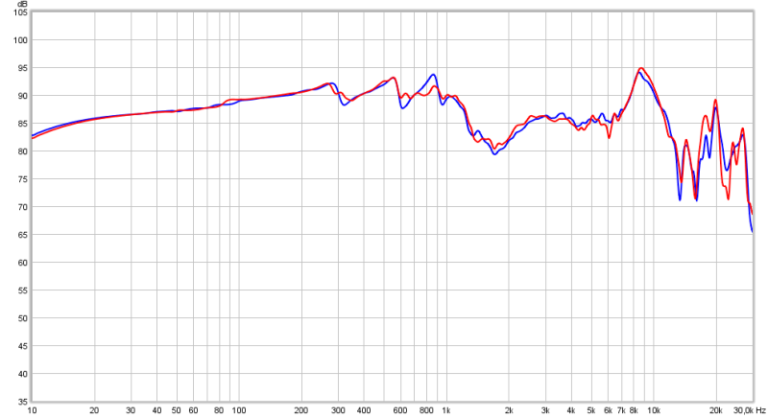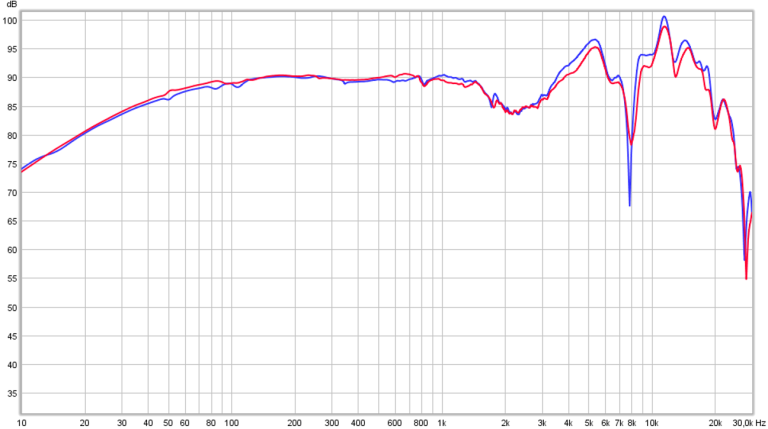I’ve observed something a little curious about my copy of the Sundara and your input would be welcome.
I bought a pair from an official retailer (
Son-Video.fr) which had been out of stock for a while and only recently received a new shipment. On the box there is a stamped date mentioning April 2021 - the shipping date out of China ? The pads are of the bulging seams kind, so I’m going to assume that it’s the “revised” version.
Something that I’ve started to become quite a bit wary of in regards to FR curves are sharp, high-Q asymmetrically sloped features of that kind (which you’ll quite frequently see with quite a few planars BTW) :

Not that it looks bad per se - at such a low magnitude I probably wouldn’t be able to hear it… if indeed it turned out to measure like this on my own head.
Thing is, when I started listening to my pair I noticed that something wasn’t quite right. Running sweeps I could indeed easily notice that sharp peak then dip around 1kHz or so. Since I felt that I wouldn’t be able to hear it to such an extent if it was as moderate as it measures on this site - or on some others - I went for the next step.
I’ve started to use in-concha microphones to measure headphones’ FR below 1kHz or so. More here :
https://www.head-fi.org/threads/the...-at-a-breakthrough-value.943107/post-16300055
With some larger over-ears I find the data in the 1kHz-3kHz or so range obviously inaccurate but still somewhat exploitable with care in relative terms between headphones.
This is how my pair of HD560S (Left and right channels, top traces), HD650 (Left and Right channels, middle traces) and this pair of Sundara (left and right channels, bottom traces) measure :
Don’t look too hard at the small recurring channel imbalances / tilt, if you look at the scale it’s within fairly narrow values (0.5-1dB) for the most part and a byproduct of pads compression / seal, placement variation, left and right microphones calibration - there’s one for each ear, etc. These traces are individual measurements but they’re representative of an average of five measurements where both the microphones and the headphones were re-positioned (I can provide the five individual traces for each headphones and the average, they basically overlap each others for the most part, with these specific headphones in that frequency range I get decent repeatability with these microphones even from day to day if you consider 0.5-1dB decent repeatability).
The results seem to be that this pair produces on my head a very sharp dip between 1-2kHz on both channels, with a sharper slope on the right channel in orange (and I can’t help but notice another interesting dip higher up, at around 2500Hz on the same channel, that seems to be a multiplier of the first, while the left channel remains better behaved - a coïncidence or something more interesting ?).
It doesn't look quite like the older revision that was depressed in the 1000-3000Hz range, the drop is a lot sharper and more similar to what the newer units seem to produce in some measurements, albeit with a larger magnitude.
As a side note you’ll also see that the bass response isn’t that much stronger in the sub-bass than with some other open over-ears - not necessarily a surprise, some (but not all) other websites measuring the more recent version also got similar results (Rtings, among others). Sean Olive’s copy which measurements were shown here showed something similar. The way the bass response is shaped between the left and right channels on the Sundara suggest to me that there is a
slightly different seal quality between the channels.
Since this is in the range where in-concha microphones start to be increasingly less reliable, just to make sure I fired up my prototype probe / tube microphones (based on a David Griesinger idea). More details about it here :
https://www.head-fi.org/threads/the...-at-a-breakthrough-value.943107/post-16339008
It’s a work in progress so read even less into it than with the in-concha mics (calibration is an issue, but the most egregious peaks should have been effectively neutered), and besides I didn’t shove it quite as far as I should for accurate measurements above a few kHz as it was a quick job and I didn’t want to fiddle with it too much. But at least up to 3-4kHz the values should be at least a decent
representation (with this sort of microphone, the values change with insertion depth, but there is a point beyond which they’re stable and stop changing - the higher the frequency, the deeper the insertion needs to be to reach stability. With these measurements that’s the case at least up to 3kHz for sure, I’ve designed the probe to be slidable without moving the headphones and progressively insert the probe while making regular measurements to make sure). The probe wasn’t moved between the measurements of the three different headphones.
Here it is, for the right channel only (HD560S in green, HD650 in blue, Sundara in red) :
So with a completely different microphone approach we can see the same dips at around 1250 and 2500Hz on the right channel.
I’ve tried to change position of the Sundara, apply a bit more pressure on the pads, etc. to not much avail in regards to the 1-2kHz problems even if it did change slightly the bass response (emphasis on slightly, I have a feeling that the air gap is happening somewhere else than between the pads and my skin anyway - perhaps the fact that only the
inside edge of the pads seals against my head and air passes through the perforated platter on the inside and the vented fabric facing my head, the latter of which is not being pressed against my skin near the
outside edge under normal use and even when pressing the pads a bit).
What I’m wondering now is :
- Since both channels exhibit a fairly sharp and strong peak then drop, if it is a question of sample variation, at least the driver pairing process and the resulting manufacturing ensure decent channel balance. Does Hifiman practice driver pairing at the factory (for example the way Sennheiser seems to do, even at a fairly cheap price point, for their passive audiophile headphones) ? Or would it be a case of low variation within batches and higher variation inter batches ?
- If it isn’t a question of sample variation, could it be the result of the interaction between the headphones and my own individual anatomy ? Any pointers as to what mechanism would be at play in that case in that 1-2kHz range ?




